1993 CADILLAC SEVILLE oil level
[x] Cancel search: oil levelPage 153 of 407
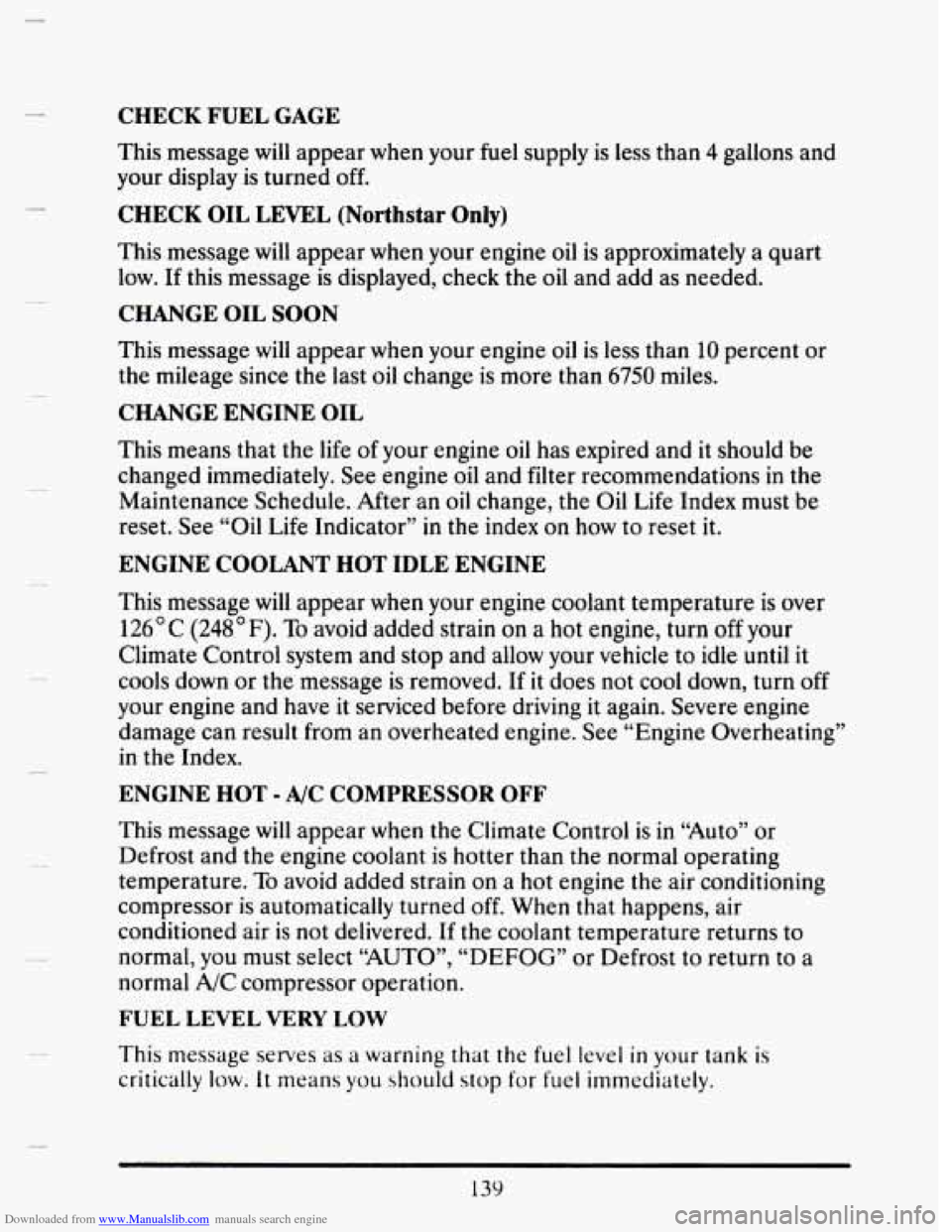
Downloaded from www.Manualslib.com manuals search engine CHECK FUEL GAGE
This message will appear when your fuel supply is less than 4 gallons and
your display
is turned off.
CHECK OIL LEVEL (Northstar Only)
This message will appear when your engine oil is approximately a quart
low. If this message is displayed, check the
oil and add as needed.
CHANGE OIL SOON
This message will appear when your engine oil is less than 10 percent or
the mileage since
the last oil change is more than 6750 miles.
CHANGE ENGINE OIL
This means that the life of your engine oil has expired and it should be
changed immediately. See engine oil and filter recommendations
in the
Maintenance Schedule. After an oil change, the Oil Life Index must be
reset. See “Oil Life Indicator”
in the index on how to reset it.
ENGINE COOLANT HOT IDLE ENGINE
This message will appear when your engine coolant temperature is over
126°C (248°F). To avoid added strain on a hot engine, turn off your
Climate Control system and stop and allow your vehicle to idle until
it
cools down or the message is removed. If it does not cool down, turn off
your engine and have it serviced before driving it again. Severe engine
damage can result from an overheated engine. See “Engine Overheating”
in the Index.
ENGINE HOT - A/C COMPRESSOR OFF
This message will appear when the Climate Control is in “Auto” or
Defrost and the engine coolant is hotter than
the normal operating
temperature. To avoid added strain on a hot engine the air conditioning
compressor is automatically turned
off. When that happens, air
conditioned air
is not delivered. If the coolant temperature returns to
normal, you must select
“AUTO”, “DEFOG” or Defrost to return to a
normal A/C compressor operation.
FUEL LEVEL VERY LOW
This message serves as a warning that the fuel level in your tank is
critically low. It means you shwld stop for fuel immediately.
139
Page 215 of 407
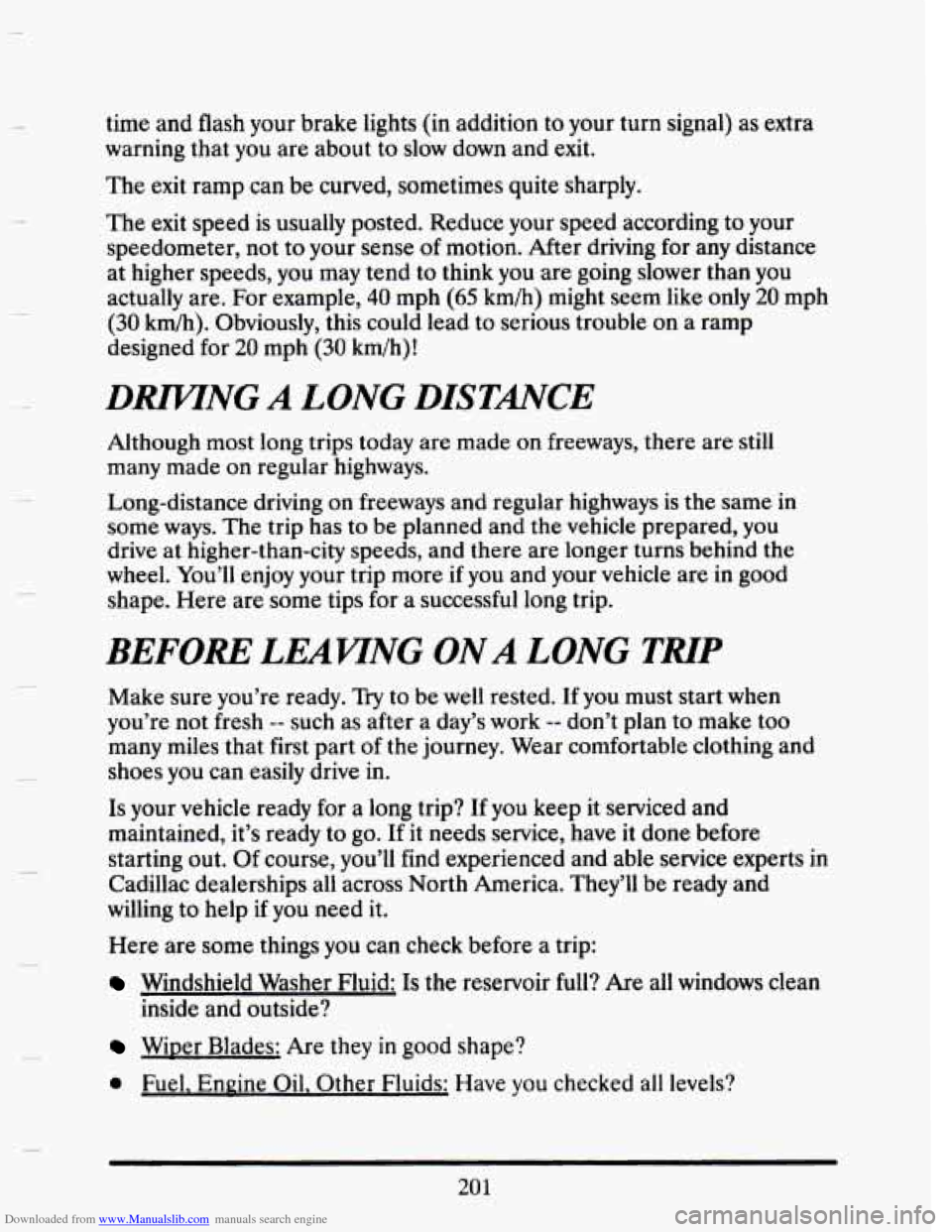
Downloaded from www.Manualslib.com manuals search engine time and flash your brake lights (in addition to your turn signal) as extra
warning that you are about to slow down and exit.
The exit ramp can be curved, sometimes quite sharply.
The exit speed is usually posted. Reduce your speed according
to your
speedometer, not to your sense
of motion. After driving for any distance
at higher speeds, you may tend to think you are going slower than you
actually are. For example,
40 mph (65 km/h) might seem like only 20 mph
(30 km/h). Obviously, this could lead to serious trouble on a ramp
designed for
20 mph (30 km/h)!
DMNG A LONG DISTANCE
Although most long trips today are made on freeways, there are still
many made
on regular highways.
Long-distance driving on freeways and regular highways is the same
in
some ways. The trip has to be planned and the vehicle prepared, you
drive at higher-than-city speeds, and there are longer turns behind
the
wheel. You’ll enjoy your trip more if you and your vehicle are in good
shape. Here are some tips for a successful long trip.
BEFORE LEAWNG ONA LONG THP
Make sure you’re ready. Try to be well rested. If you must start when
you’re not fresh
-- such as after a day’s work -- don’t plan to make too
many miles that first part of
the journey. Wear comfortable clothing and
shoes
you can easily drive in.
Is your vehicle ready for a long trip? If you keep it serviced and
maintained, it’s ready to
go. If it needs service, have it done before
starting out. Of course, you’ll find experienced and able service experts
in
Cadillac dealerships all across North America. They’ll be ready and
willing to help
if you need it.
Here are some things
you can check before a trip:
Windshield Washer Fluid: Is the reservoir full? Are all windows clean
inside and outside?
Wiper Blades: Are they in good shape?
0 Fuel. Enpine Oil. Other Fluids: Have you checked all levels?
201
Page 251 of 407
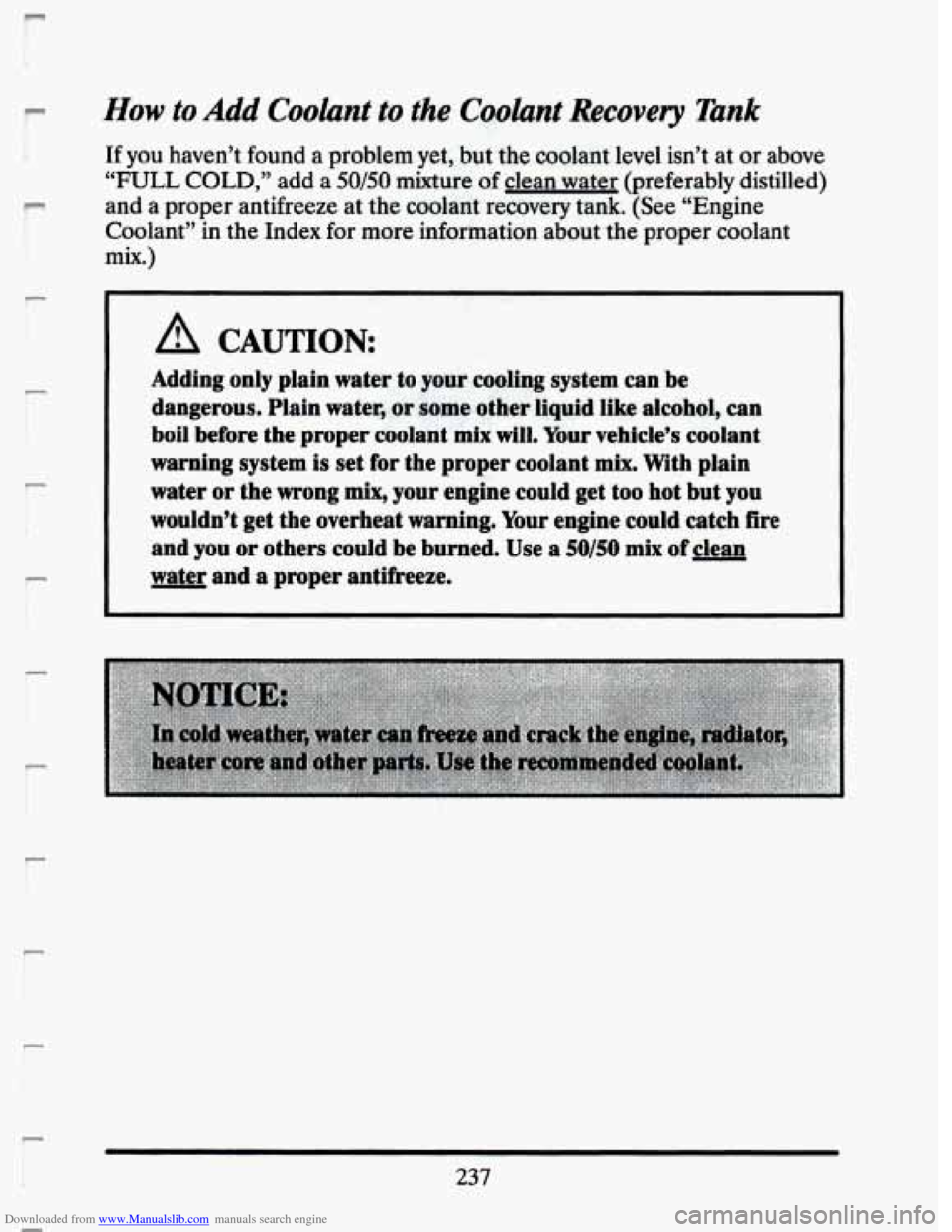
Downloaded from www.Manualslib.com manuals search engine L ..
r-
r
r
t
How to Add Coolant to the Coolant Recovery Tank
If you haven’t found a problem yet, but the coolant level isn’t at or above
“FULL COLD,” add a 50/50 mixture of clean water (preferably distilled)
and
a proper antifreeze at the coolant recovery tank. (See “Engine
Coolant” in the Index for more information about the proper coolant
mix.)
A CAUTION
Adding only plain water to your cooling system can be
dangerous. Plain water, or some other liquid like alcohol, can
boil before the proper coolant
mix will. Your vehicle’s coolant
warning system is set for the proper coolant
mix. With plain
I water or the wrong mix, your engine could get too hot but you
~ wouldn’t get the overheat warning. Your engine could catch fire
~ and you or others could be burned. Use a 50/50 mix of clean
~ water and a proper antifreeze.
r
r 237
Page 258 of 407
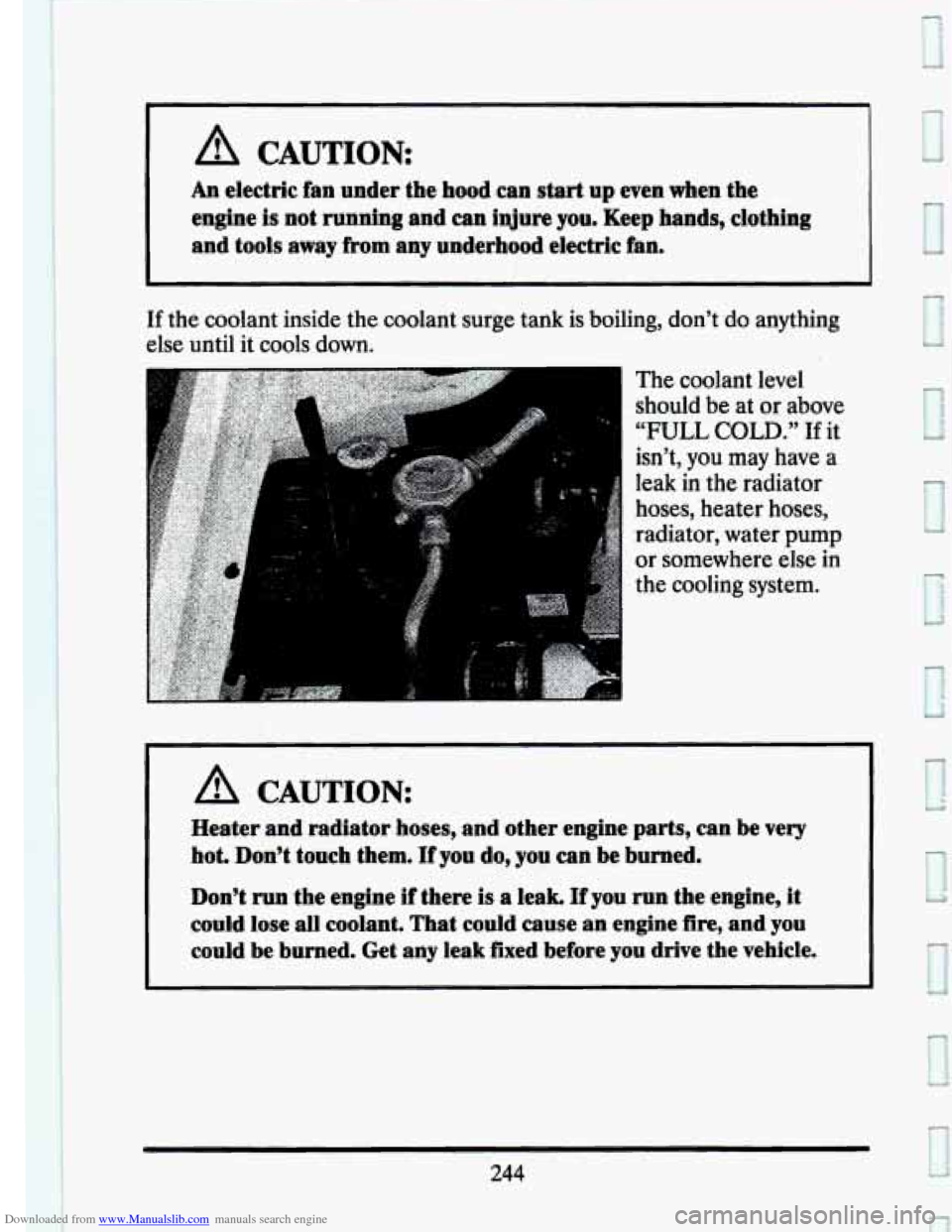
Downloaded from www.Manualslib.com manuals search engine I A CAUTION
An electric fan under the hood can start up even when the
engine
is not running and can injure you. Keep hands, clothing
and tools
away from any underhood electric fan.
If the coolant inside the coolant surge tank is boiling, don’t do anything
else until it cools
down.
The coolant level
should be at or above
“FULL COLD.” If it
isn’t,
you may have a
leak in the radiator
hoses, heater hoses,
radiator, water pump
or somewhere else in
the cooling
system.
A CAUTION:
Heater and radiator hoses, and other engine parts, can be very
hot. Don’t touch them.
If you do, you can be burned.
Don’t
run the engine if there is a leak If you run the engine, it
could lose
all coolant. That could cause an engine fire, and you
could be burned. Get any leak fixed before you drive the vehicle.
244
Page 259 of 407
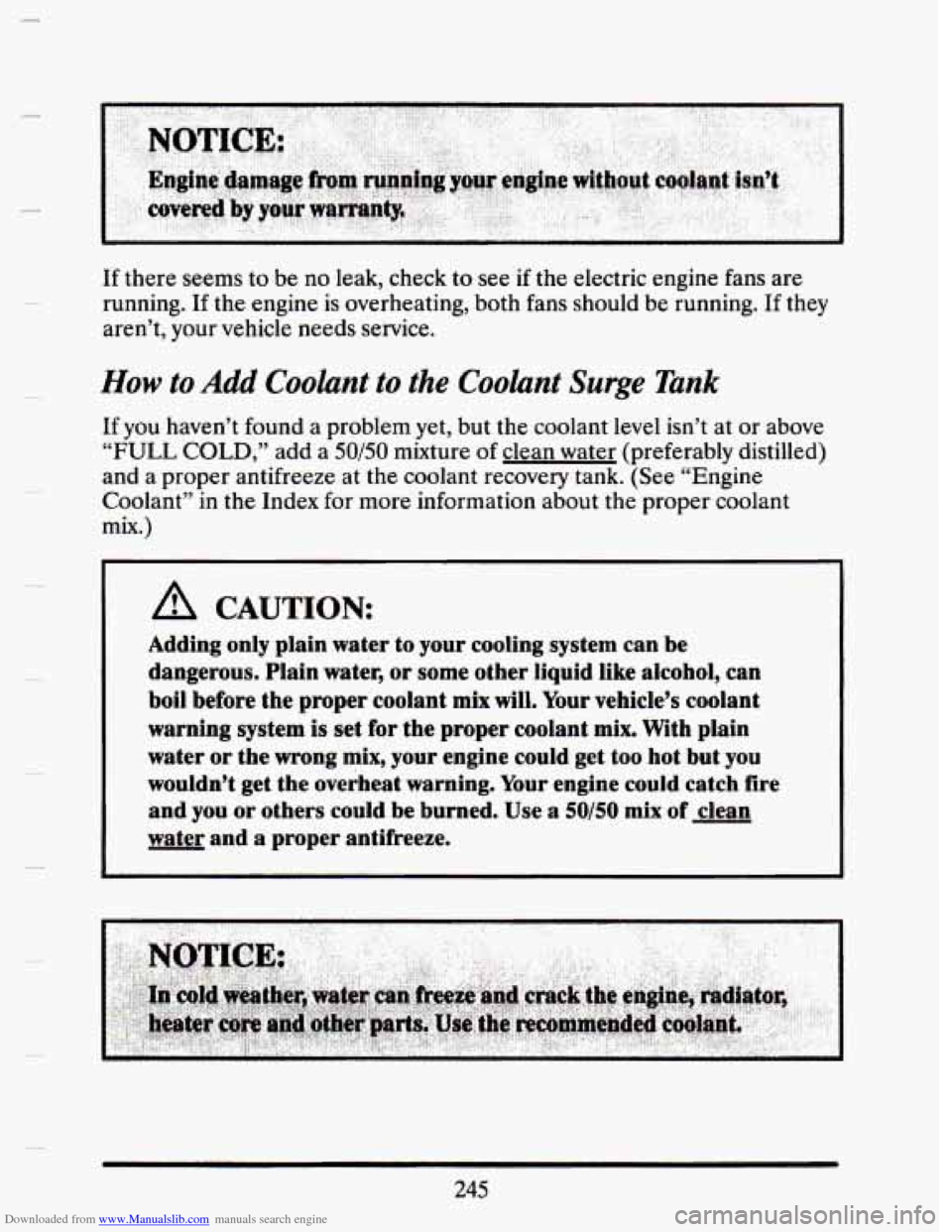
Downloaded from www.Manualslib.com manuals search engine ...-
c
If there seems to be no leak, check to see if the electric engine fans are
running. If the engine
is overheating, both fans should be running. If they
aren’t, your vehicle needs service.
How to Add Coolant to the Coolant Surge Tank
If you haven’t found a problem yet, but the coolant level isn’t at or above
“FULL COLD,” add a 50/50 mixture of clean water (preferably distilled)
and a proper antifreeze at
the coolant recovery tank. (See “Engine
Coolant”
in the Index for more information about the proper coolant
mix.)
A CAUTION
Adding only plain water to your cooling system can De
dangerous. Plain water, or some other liquid like alcohol, can
boil before the proper coolant mix will.
Your vehicle’s coolant
warning system is set
for the proper coolant mix. With plain
water
or the wrong mix, your engine could get too hot but you
wouldn’t get the overheat warning. Your engine could catch fire
and you or others could be burned. Use a
50/50 mix of clean
water and
a proper antifreeze.
245
Page 283 of 407
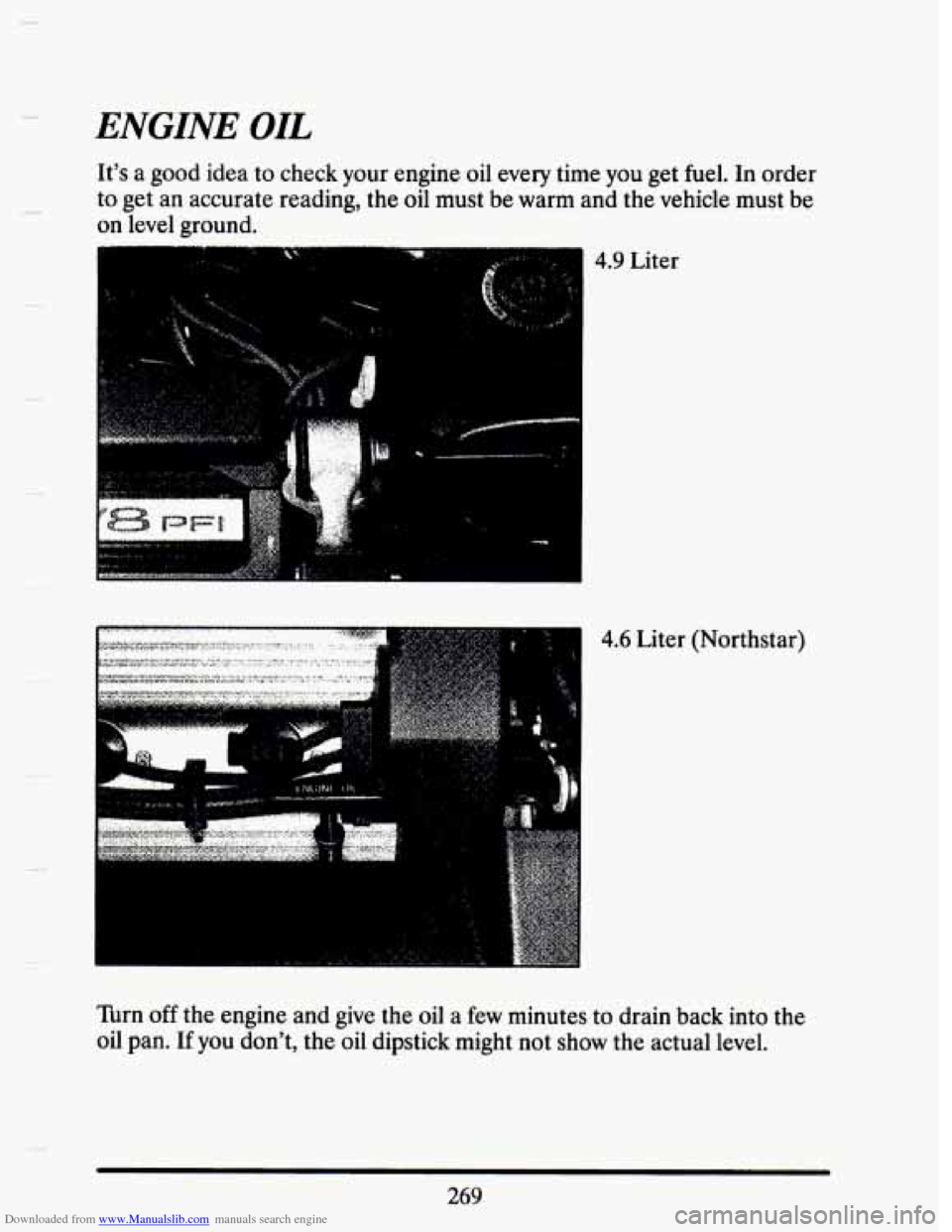
Downloaded from www.Manualslib.com manuals search engine ENGINE OIL
It’s a good idea to check your engine oil every time you get fuel. In order
to get an accurate reading,
the oil must be warm and the vehicle must be
on level ground.
..
4.9 Liter
4.6 Liter (Northstar)
Turn
off the engine and give the oil a few minutes to drain back into the
oil pan. If
you don’t, the oil dipstick might not show the actual level.
269
Page 287 of 407

Downloaded from www.Manualslib.com manuals search engine I
lr;
f
c f
r
r
!
i
t
P
i
r“ i i
i
Just fill it enough to put the level somewhere in the proper operating
range. Push the dipstick all the way back
in when you’re through.
What Kind of Oil to Use:
Look for three things:
SG
“SG” must be on the oil container, either by itself or combined with
other quality designations, such as
“SG/CC,,” “SG/CD,” ggs~s~,~c,9’
etc. These letters show American Petroleum Institute (MI) levels of
quality.
273
Page 289 of 407
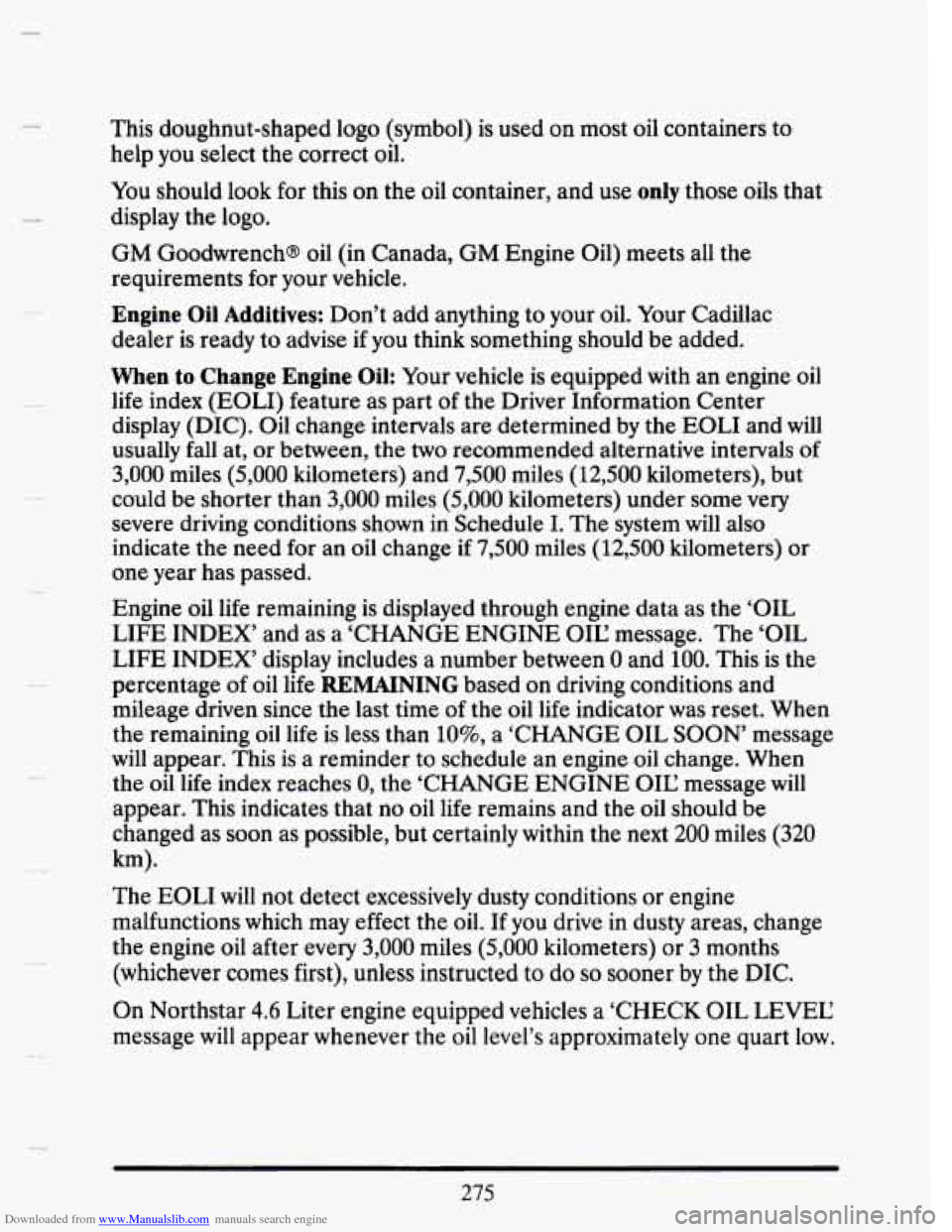
Downloaded from www.Manualslib.com manuals search engine This doughnut-shaped logo (symbol) is used on most oil containers to
help you select the correct oil.
You should look for this on the oil container, and use
only those oils that
display the logo.
GM Goodwrench@ oil
(in Canada, GM Engine Oil) meets all the
requirements for your vehicle.
Engine Oil Additives: Don’t add anything to your oil. Your Cadillac
dealer
is ready to advise if you think something should be added.
When to Change Engine Oil: Your vehicle is equipped with an engine oil
life index (EOLI) feature as part of the Driver Information Center
display (DIC). Oil change intervals are determined
by the EOLI and will
usually fall at, or between, the two recommended alternative intervals of
3,000 miles (5,000 kilometers) and 7,500 miles (12,500 kilometers), but
could
be shorter than 3,000 miles (5,000 kilometers) under some very
severe driving conditions shown in Schedule I. The system will also
indicate the need for an
oil change if 7,500 miles (12,500 kilometers) or
one year has passed.
Engine oil life remaining
is displayed through engine data as the ‘OIL
LIFE INDEX’ and as a
‘CHANGE ENGINE OIL message. The ‘OIL
LIFE INDEX’ display includes a number between
0 and 100. This is the
percentage
of oil life REMAINING based on driving conditions and
mileage driven since the last time
of the oil life indicator was reset. When
the remaining oil life is less than
lo%, a ‘CHANGE OIL SOON’ message
will appear. This is a reminder to schedule an engine oil change. When
the oil life index reaches
0, the ‘CHANGE ENGINE OIL: message will
appear. This indicates that no oil life remains and the oil should be
changed as soon as possible, but certainly within the next 200 miles (320
km).
The EOLI will not detect excessively dusty conditions or engine
malfunctions which may effect the oil.
If you drive in dusty areas, change
the engine
oil after every 3,000 miles (5,000 kilometers) or 3 months
(whichever comes first), unless instructed
to do so sooner by the DIC.
On Northstar 4.6 Liter engine equipped vehicles a ‘CHECK OIL LEVEE
message will appear whenever the oil level’s approximately one quart low.
275